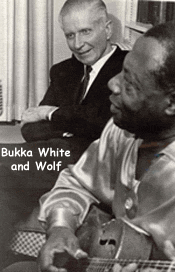John Quincy Wolf was chair of the English department at Southwestern College in
Memphis for three decades. His love of music soon drew his attention to the rich heritage of
blues musicians in the Memphis area,
 and he sent his folklore students out to record blues
musicians in the 1960s when the folk and blues revival was at its peak.
and he sent his folklore students out to record blues
musicians in the 1960s when the folk and blues revival was at its peak.
His interest in Memphis blues led him to explore the folkloric elements of W.C. Handy's "St. Louis Blues," which he did in the article "Aunt Caroline Dye: The Gypsy in "The St. Louis Blues.'" Wolf also befriended a number of musicians in the 1960s, including the famous bluesmen Gus Cannon, Furry Lewis, and Bukka White. Wolf would visit their homes, and often invited them to come and perform for his folklore classes, recording interviews with Lewis and White.
Gus Cannon's career began in the 1920s, when his band Cannon's Jug Stompers recorded for Victor Records. While jug bands were extremely popular in many southern cities in the 1920s and 30s, it was in Memphis where the genre reached its peak, and Cannon's band was one of the best. Melding blues, ragtime, breakdowns, and humor. He wrote a song called "Walk Right In," which later became top hit by the Rooftop Singers in 1963 - without Cannon's knowledge or permission. Wolf helped Cannon obtain legal services in an effort to get Cannon's royalties for the song, and Cannon's career enjoyed a revival after the success of "Walk Right In."
Walter "Furry" Lewis originally recorded in the late 1920s, when he sang blues and a few folk tunes like "John Henry." His career was revitalized in 1959, and he became a hero to many younger musicians. The Rolling Stones asked him to be their opening act, and Canadian songwriter Joni Mitchell wrote "Furry Sings the Blues" about him. He visited Wolf's class a number of times.
Booker T. "Bukka" White moved from the hills of Mississippi to the Delta, and was inspired by Charlie Patton. White recorded a few selections in the 1930s, but ran afoul of the law and served time at Parchman Farm prison. He moved to Chicago to record in 1940, and after that his career languished. He moved to Memphis and was working as a laborer when he was rediscovered in 1964. He also encouraged his nephew B.B. King to pursue music.
Bukka White in John Quincy Wolf's Folklore Class (Audio Files)
(Date unknown -- probably 1970-71)
You will need either Windows Media Player, QuickTime, or RealOne Player to listen to the recordings.
A free version of RealOne player is available for download here.
White talks about his life and playing music.
White talks about his first guitar and meeting Charlie Patton.
White sings "Mama Don't Allow No Staying Out All Night Long."
White sings and provides commentary about "The Old Boogie."
White sings "Lucille."
White sings "Poor Boy Long Way From Home."
Some of the biographical information on Furry Lewis, Bukka White, and Gus Cannon came from Nothing But the Blues: The Music and the Musicians by Lawrence Cohn. New York: Abbeville Press, 1993.

